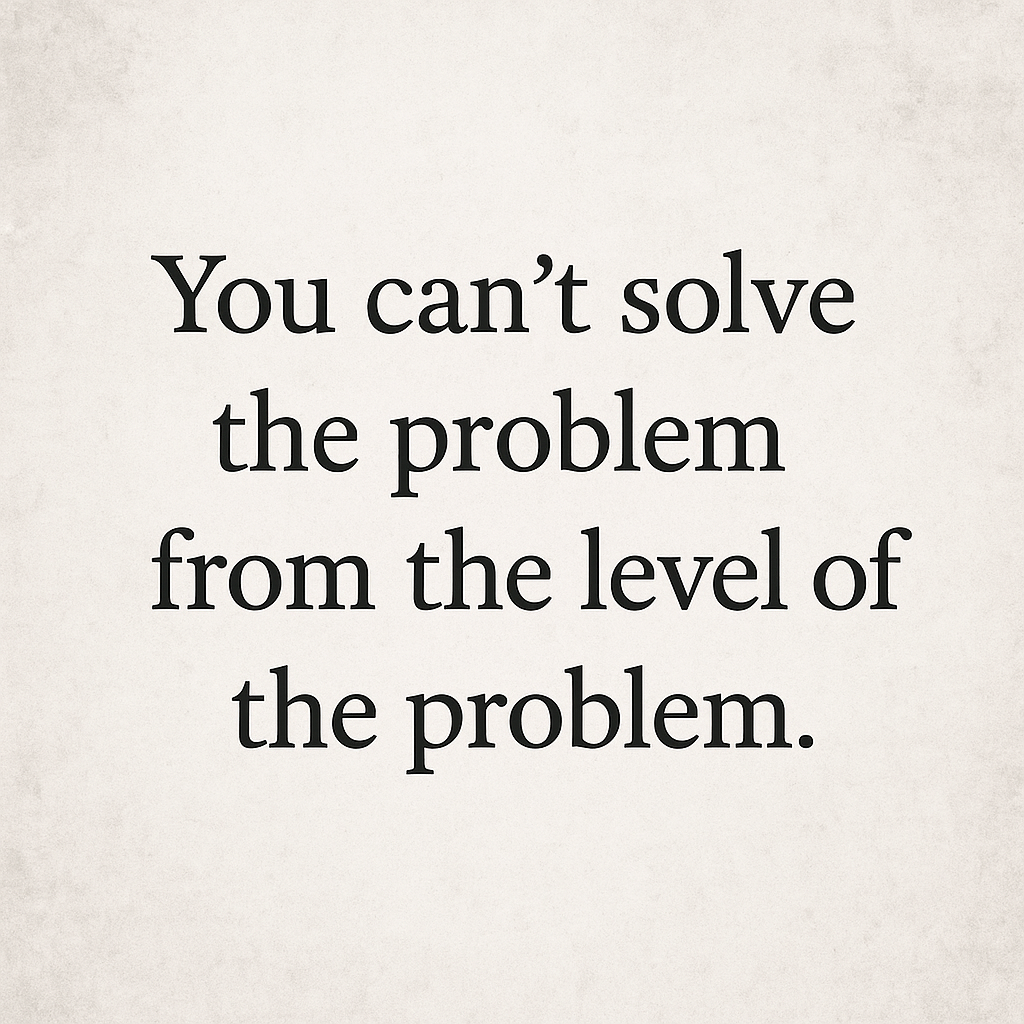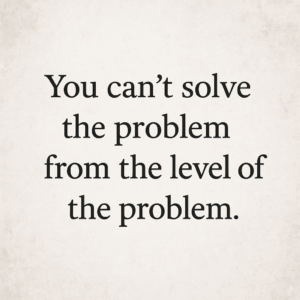I’ve been sitting with this line: “You can’t solve the problem from the level of the problem.” It’s easy to treat it like a clever slogan. It isn’t. It’s a structural truth. Problems don’t dissolve from inside the same mindset, assumptions, or architecture that produced them. Harder work and tighter focus just reinforce the loop.
After reflecting on it, I realized this principle explains why certain issues linger for years while others disappear overnight. It also explains how you can resolve a draining, recurring issue in your own life and work—starting now.
But why can’t you actually solve a problem from the level that created it? Four big reasons really:
1. At the same level, the system recurses.
When you stay at the level of the problem, the system recurses. It runs the same pattern again and again because that’s the only pattern it knows how to run.
Recursion means the system feeds on its own logic. It uses the same assumptions, same incentives, same constraints, and then produces the same outcomes—no matter how hard you push.
You get action, but no resolution.
Movement, but no progress.
Noise, but no transformation.
The structure routes energy into the old groove. It defaults to the familiar path. It protects the very pattern you’re trying to exit.
This is why spinning feels so familiar: you’re not moving forward. You’re looping inside the same architecture.
2. Every problem has a context layer above it.
Every problem sits inside a surrounding context window (yes, I’m borrowing an AI term to because it fits!) — a frame of history, meaning, incentives, identity, and constraints. This context determines what the system pays attention to, what it ignores, and what it believes is possible.
Stay inside that frame and you inherit its blind spots. You’re trying to solve the problem from within the very story that produced it. You can’t see the full pattern because you’re standing inside its history.
The right context window is the one above or adjacent to the problem — the vantage point that defines the rules of the game. Shift the context, and the rules shift with it.
Change the frame → change the game.
3. The problem is entangled with the level that created it.
This is where people feel trapped.
The system protects its own design.
Structures work to preserve themselves.
What you’re fighting isn’t an anomaly — it’s the expected output of the architecture you’re standing in.
You can’t out-think a system while living inside its constraints.
A flawed structure beats good intentions every time.
So you replay its logic, even when you know better.
Discipline fades.
Willpower buckles.
“Trying harder” becomes self-sabotage.
The problem is fused to the frame.
Shift the frame → the pattern breaks.
4. Solutions emerge only when you rise above the frame.
The solution isn’t more positive thinking, or greater effort. It’s to change the structure.
A structural shift means stepping into a frame that carries more coherence than the one producing the problem. You’re not erasing the past or rewriting history. You’re changing the perspective the system uses to interpret its history, allocate energy, and make sense of what’s happening now.
At a higher frame, the defaults change:
Different assumptions — the meaning you assign to events shifts.
Different constraints — the boundaries and permissions are redefined.
Different identity — the “who I am in this system” changes its reference point.
Different governing principle — a new rule-set organizes behavior.
Different source of attention — what the system considers signal vs. noise evolves.
This new frame reroutes energy.
Patterns that once had gravity lose it.
Interpretations that once felt inevitable dissolve.
At this level, the old problem can’t maintain its structure.
It was propped up by the logic of the prior frame.
Remove that logic, and the problem collapses under its own weight.
That’s emergence:
The higher frame organizes the lower.
How Would You Fix Slow Execution?
Its usually easy to see when execution bogs down: deadlines slip, meetings drag, and cross-functional work feels like wading through mud.
The instinctive response is to tighten the screws—add more tickets, more dashboards, more status meetings, and more oversight. But all of those “fixes” operate at the same level as the problem. They reinforce the very architecture that is producing the friction.
In Organizational Physics terms, slow execution usually has little to do with effort alone. It’s structural. When work slows down, it’s usually because the system is running on competing priorities and accountabilities, bottlenecked throughput, fragmented information, and/or a mismatch with the lifecycle stage of the business or product line. Leaders get overloaded with responsibilities that don’t belong to them, and the organization starts routing every decision and action through the same narrow channels. Velocity collapses.
So what actually improves execution? A structural shift.
Start by clarifying the lifecycle stage strategy. Then design a structure that actually matches that stage. Strip out competing accountabilities by giving every role a dominant orientation, a clear purpose, and an aligned scope. This single move removes an enormous amount of friction because people stop guessing, stop compensating, and start focusing on what truly matters for the stage.
Next, unify the information flow. When teams don’t share a single source of truth, they create their own. That produces conflicting priorities, endless rework, and spiraling coordination costs. One. Single. Source. Of. Truth.
Build in the management operating system—the cadences, commitments, priorities, and feedback loops that keep the organization aligned. Without an operating system, leaders rely on heroics and memory. With one, the structure and process create agility and realignment.
Finally, introduce an Enterprise AI layer that ties everything together. This layer connects context, automates coordination, and reduces the managerial load that slows companies down as they scale. It becomes the connective tissue across roles, teams, priorities, and workflows.
When these structural and process elements fit into place, execution accelerates without more effort. Work moves faster because the architecture supports speed. The old problems dissolve because the new frame doesn’t sustain them.
Change the structure → change in behavior.
When you try to solve a problem from its own level, you generate more problems. The system recycles its logic and multiplies its constraints.
Step back and the principle is obvious:
Problems persist when the system attempting to solve them is operating at the same level that created them.
The breakthrough comes from rising above the frame —
not escaping the problem, but outgrowing it.
Change the architecture and behavior shifts.
Upgrade the frame and the old pattern loses its gravity.
That’s the physics of real transformation.




